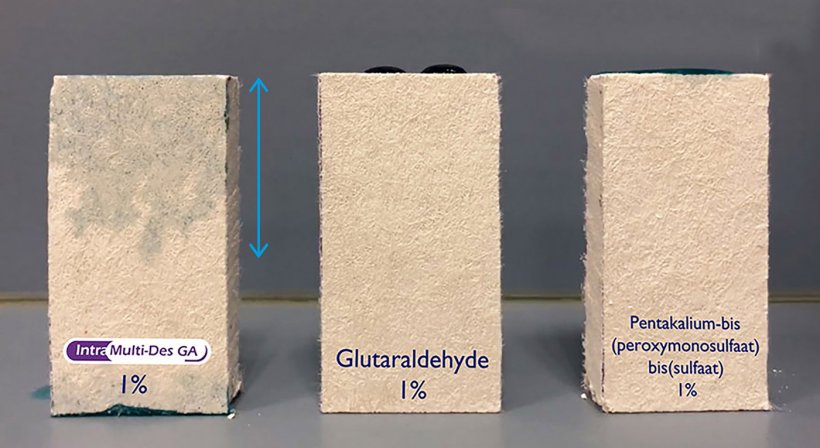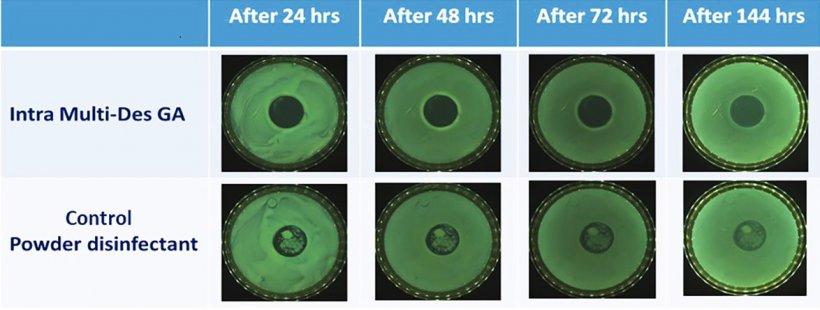
African Swine Fever
The recent outbreak of African Swine Fever (ASF) in Asia has turned into a devastating worldwide crisis. The application of strict biosecurity measures specific to the different swine producing sectors including thorough cleaning and disinfection protocols for all surfaces in contact with animals and their excretions are the only solution to prevent entry of the virus into susceptible farms. However, especially at the typical Asian small-scale backyard farms with an open housing system, it may be challenging to obtain a sufficient level of biosecurity.

Effective cleaning and disinfection
ASF virus (ASFv) has been shown to survive in feces for up to 5 days at room temperature and disinfectant potencies are highly reduced by organic soiling. For optimal disinfection, it is thus recommended to always begin with cleaning, starting with the mechanical removal of rough organic material and followed by the use of a strong cleaning agent. Being an enveloped virus, the lipid bilayer ASFv can already be disrupted by detergents like those present in Intra Foam Cleaner.
For terminal disinfection, it is vital to choose the most effective virucidal product. Glutaraldehyde has been shown to inactivate ASFv by destroying viral membranes via protein denaturation, interfering with protein-DNA interactions required for metabolism, and inducing changes of the viral capsid (protein shell), and quarternary ammonium compounds (QACs) are hydrophobic molecules that cause detachment of enveloped viruses and inactivate viruses by interaction with intraviral targets and binding to the viral DNA. This explains why QAC concentrations of as low as 0.003% have been proven effective against ASF virus.
Optimal functionality by secondary properties
It is important to realize that these excellent virucidal properties are only useful when a product is able to reach every single viral particle. Therefore, the formulation of Intra Multi-Des GA is optimized with supporting excipients to reduce its surface tension, resulting in a quadruple benefit:
- Coverage of an increased surface area (Figure 1);
- The contact between the product and the outer surface of the virus is increased, resulting in a maximum efficacy in practice (Figure 1);
- The product is better able to penetrate rough/irregular surfaces to reach hidden virus particles (Figures 1 and 2);
- Long-term residual activity even after evaporation of the product (Figure 3).

During application of a disinfectant by spraying or fogging it is important to create a small droplet size to reach all corners of the surface to be treated. Upon touching the surface, a droplet has to flow homogeneously to reach a maximum surface per droplet and run freely to reach all hidden spots (Figure 1). The pictures in Figure 2 clearly show that a bigger surface and deeper penetration is reached with Intra Multi-Des GA compared to glutaraldehyde and a control product that is advertised in Asia.

Long-term residual action
Especially in areas with hot climates, like present in Asia, disinfectants may rapidly lose their activity upon drying. Using a stamp test, a 0.5% product solution was dried at room temperature and stamped for 2 seconds on bacteria culture plates inoculated with Pseudomonas aeruginosa. After 24-72 hours incubation, the culture plates were completely covered with bacteria, except from the area stamped with dried Intra Multi-Des GA (Figure 3). This clearly shows that even after evaporation Intra Multi-Des GA is able to prevent bacterial growth for the duration of at least 3 days, in contrast to an in Asia available control product that allowed bacterial growth within 24 hours.

Proven efficacy against ASF virus
According to the latest European Biocidal Product Regulations (BPR), a disinfectant is allowed to claim general virucidal efficacy when it is able to achieve a 10,000-fold reduction in the most difficult to kill Enteric Cytopathic Bovine Orphan virus (ECBO). Intra Multi-Des GA was able to reach this 10,000-fold reduction within 30 minutes at a concentration of only 0.75% under the prescribed low temperature of 10 °C and in the presence of soiling. The ability of Intra Multi-Des GA to inactivate the most resistant virus also demonstrates the ability of this biocide to inactivate the weaker, lipid enveloped virus of ASFv. In conclusion, Intra Multi-Des GA is the biocide of choice for protection of your farm against African Swine Fever.

January 6, 2020 - Intracare



